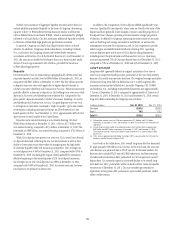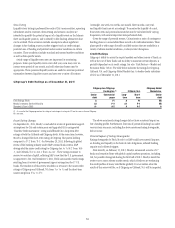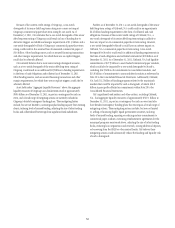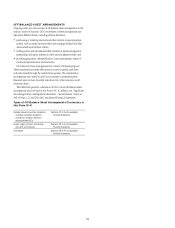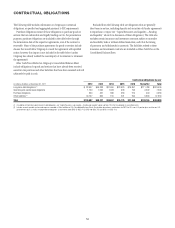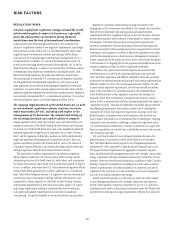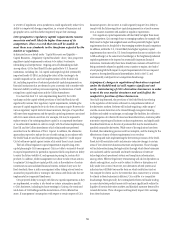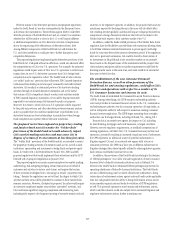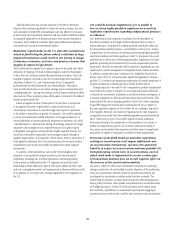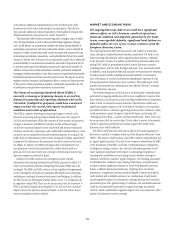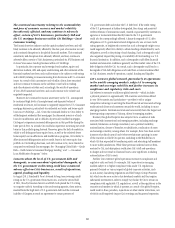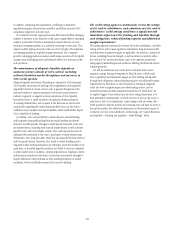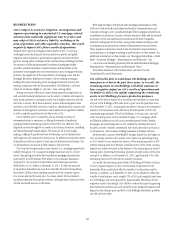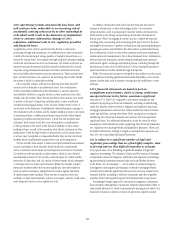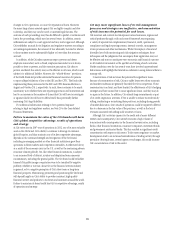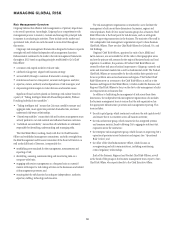Citibank 2011 Annual Report Download - page 80
Download and view the complete annual report
Please find page 80 of the 2011 Citibank annual report below. You can navigate through the pages in the report by either clicking on the pages listed below, or by using the keyword search tool below to find specific information within the annual report.58
The Dodd-Frank Act also provides authority to the SEC to determine
fiduciary duty standards applicable to brokers for retail customers. Any new
such standards or related SEC rulemakings could also affect Citi’s business
practices with retail investment customers and have indirect additional effects
on standards applicable to its business practices with certain institutional
customers. Such standards could also likely entail additional compliance
costs and result in potential incremental liability.
Regulatory requirements in the U.S. and other jurisdictions
aimed at facilitating the future orderly resolution of large
financial institutions could result in Citi having to change
its business structures, activities and practices in ways that
negatively impact its operations.
The Dodd-Frank Act requires Citi to prepare a plan for the rapid and orderly
resolution of Citigroup, the bank holding company, under the Bankruptcy
Code in the event of future material financial distress or failure. Citi is also
required to prepare a resolution plan for its insured depository institution
subsidiary, Citibank, N.A., and to demonstrate how it is adequately
protected from the risks presented by non-bank affiliates. These plans
must include information on resolution strategy, major counterparties and
“interdependencies,” among other things, and will require substantial effort,
time and cost. These resolution plans will be subject to review by the Federal
Reserve Board and the FDIC.
Based on regulator review of these plans, Citi may have to restructure
or reorganize businesses, legal entities, or operational systems and
intracompany transactions in ways that negatively impact its operations,
or be subject to restrictions on growth. For example, Citi could be required
to create new subsidiaries instead of branches in foreign jurisdictions, or
create subsidiaries to conduct particular businesses or operations (so-called
“subsidiarization”), which would, among other things, increase Citi’s legal,
regulatory and managerial costs, negatively impact Citi’s global capital
and liquidity management and potentially impede its global strategy. Citi
could also eventually be subjected to more stringent capital, leverage or
liquidity requirements, or be required to divest certain assets or operations, if
both regulators determine that Citi’s resolution plans do not meet statutory
requirements and Citi does not remedy the deficiencies within required
time periods.
In addition, other jurisdictions, such as the United Kingdom, have
requested or are expected to request resolution plans from financial
institutions, including Citi, and the requirements and timing relating
to these plans are different from the U.S. requirements and each other.
Responding to these additional requests will require additional effort, time
and cost, and regulatory review and requirements in these jurisdictions could
be in addition to, or conflict with, changes requested by Citi’s regulators in
the U.S.
Citi could be harmed competitively if it is unable to
hire or retain highly qualified employees as a result of
regulatory requirements regarding compensation practices
or otherwise.
Citi’s performance and competitive standing is heavily dependent on
the talents and efforts of the highly skilled individuals that it is able to
attract and retain. Competition for highly qualified individuals within the
financial services industry has been, and will likely continue to be, intense.
Compensation is a key element of attracting and retaining highly qualified
employees. Banking and other regulators in the U.S., European Union and
elsewhere are in the process of developing principles, regulations and other
guidance governing what are deemed to be sound compensation practices
and policies. However, the steps that will be required to implement any new
requirements, and the consequences of implementation, remain uncertain.
In addition, compensation may continue to be a legislative focus both in
Europe and in the U.S. as there has been significant legislation in Europe
and the U.S. in recent years regarding compensation for certain employees of
financial institutions, including provisions of the Dodd-Frank Act.
Changes required to be made to Citi’s compensation policies and practices
may hinder Citi’s ability to compete in or manage its businesses effectively,
to expand into or maintain its presence in certain businesses and regions, or
to remain competitive in offering new financial products and services. This
is particularly the case in emerging markets, where Citi is often competing
for qualified employees with financial institutions that are not subject to
the same regulatory regimes as Citi and that are also seeking to expand in
these markets. Moreover, new disclosure requirements or other legislation
or regulation may result from the worldwide regulatory processes described
above. If this were to occur, Citi could be required to make additional
disclosures relating to the compensation of its employees or to restrict or
modify its compensation policies, any of which could hurt its ability to
hire, retain and motivate its key employees and thus harm it competitively,
particularly in respect of companies not subject to these requirements.
Provisions of the Dodd-Frank Act and other regulations
relating to securitizations will impose additional costs
on securitization transactions, increase Citi’s potential
liability in respect of securitizations and may prohibit Citi
from performing certain roles in securitizations, each of
which could make it impractical to execute certain types
of transactions and may have an overall negative effect on
the recovery of the securitization markets.
Citi plays a variety of roles in asset securitization transactions, including
acting as underwriter of asset-backed securities, depositor of the underlying
assets into securitization vehicles, trustee to securitization vehicles and
counterparty to securitization vehicles under derivative contracts. The
Dodd-Frank Act contains a number of provisions that affect securitizations.
Among other provisions, these include a requirement that securitizers retain
un-hedged exposure to at least 5% of the economic risk of certain assets
they securitize, a prohibition on securitization participants engaging in
transactions that would involve a conflict with investors in the securitization,


